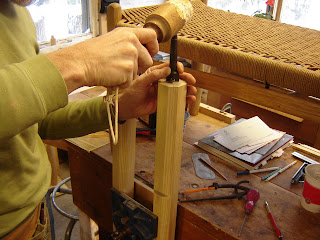
I'm marking the sides of the shallow sockets. This face is rounded so I cut a shallow socket to bear against the end of the rung. I use the flat face of the leg to register the blade of my double square. The thickness of its body gives me an offset straightedge that locates the sides of my socket.
I use 2 identical routers, with different bits. One to cut the socket then another for the deeper mortise. This shot shows a leg with its joinery completed for this face. I use a 5/8" bit to cut the sockets. This 5/16" bit cuts the mortises. I work from the flat top against a stop to locate my heights.
All the rungs are milled slightly oversized in both width and thickness and given a centered mortise.
Fitting begins with shaping the top to match the socket and adjusting thickness to tight. Here I butt the top of the rung against the top of the socket and mark the bottom of the rung on the leg. This outline shows me where the rung is larger than the socket and where I need to remove material.
Prior to fitting each arm I need to glue together its 2 pieces. These came out of the same board. Its thickness was the width of the rung. I rip off the rung, then re-saw the offcut to get the thiner wing. Then the finished arm looks as if it were shaped from a single piece.














